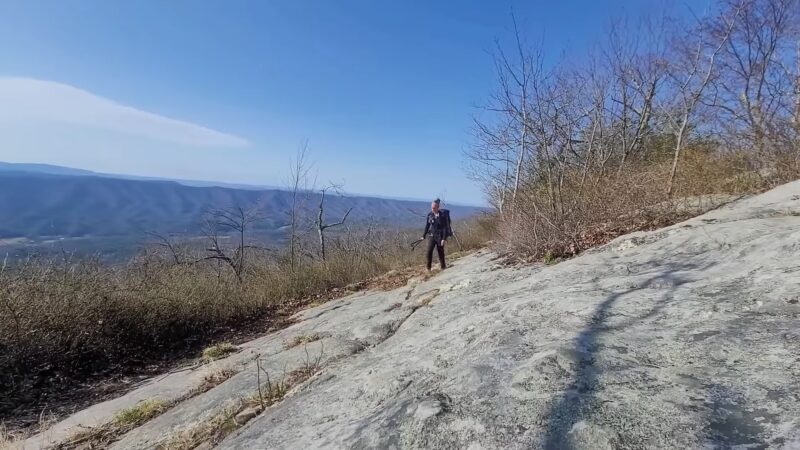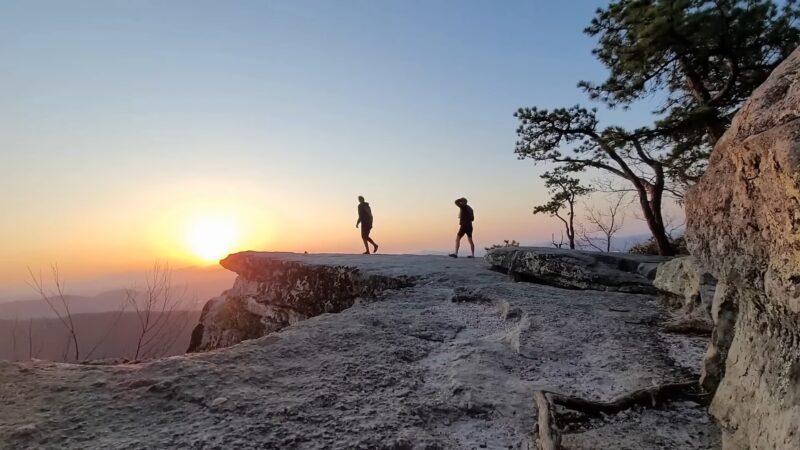The Appalachian Trail, often fondly referred to as the AT, is a marvel that stretches over 2,000 miles across the eastern United States. It’s a journey that many hikers dream of conquering, and for good reason.
The trail offers a unique blend of natural beauty, challenging terrains, and a sense of accomplishment that’s hard to match. But before you lace up those hiking boots, it’s essential to understand the time commitment involved.
The AT in a Nutshell

Spanning a total length of 2,193 miles, the AT is a long-distance hiking trail that begins in Springer Mountain, Georgia, and culminates at Mount Katahdin in Maine. But it’s not just the length that’s impressive.
The trail traverses through 14 states, each offering its unique landscapes and challenges. From the rugged terrains of the White Mountains in New Hampshire to the serene beauty of the Shenandoah Valley in Virginia, the AT is a mosaic of nature’s best offerings.
And let’s not forget the challenges – steep ascents, rocky paths, and unpredictable weather are all part and parcel of the AT experience.
| State | Approximate Mileage |
| Georgia | 79 miles |
| North Carolina | 95.7 miles (plus 224.7 miles shared with Tennessee) |
| Tennessee | 71 miles (plus 224.7 miles shared with North Carolina) |
| Virginia | 550.3 miles |
| West Virginia | 4 miles |
| Maryland | 40.9 miles |
| Pennsylvania | 229.6 miles |
| New Jersey | 72.2 miles |
| New York | 88.4 miles |
| Connecticut | 51.6 miles |
| Massachusetts | 90.2 miles |
| Vermont | 150 miles |
| New Hampshire | 161 miles |
| Maine | 282.9 miles |
Factors Affecting Hiking Duration
Hiker’s Pace
One’s pace is a significant determinant of how long it’ll take to hike the AT. Naturally, if you’re a speedster, you’ll cover more ground in a day compared to someone who prefers a leisurely stroll. But it’s not just about speed.
The terrain you’re crossing, your fitness level, and the weight of your backpack all play a role in determining your pace. For instance, hiking uphill with a 40-pound pack is going to be slower than walking on a flat surface with a lighter load.
| Terrain Type | Average Hiking Speed (mph) |
| Flat | 3 |
| Uphill | 1.5 |
| Rocky | 2 |
Trail Conditions
Mother Nature can be unpredictable, and she has a significant say in your hiking experience. The season you choose to hike can drastically affect your journey. For instance, winter hikes might mean dealing with snow-covered paths, while summer could bring its own set of challenges like heat and humidity.
Moreover, trail maintenance plays a crucial role. A well-maintained section can be a breeze, but a neglected stretch might slow you down considerably.
Hiking Speed and Duration
When it comes to hiking the Appalachian Trail (AT), speed and duration are two factors that vary greatly among hikers.
Most hikers start slow, averaging eight to ten miles a day. As they get accustomed to the trail and build their stamina, they often work up to 12 to 16 miles a day. However, it’s essential to remember that everyone’s pace is different. Some days you might cover less ground, especially when navigating challenging terrains or taking in the breathtaking views, while on other days, you might feel like pushing yourself a bit more.
Now, if you’re wondering about the overall time it takes to complete the AT, the average person takes anywhere from 5 to 7 months. But for those who are in a race against time, experienced hikers aiming for the fastest known times have completed the entire trail in under 50 days. That’s some serious speed!
| Hiking Speed (miles/day) | Approximate Completion Time | Notes |
| 8-10 | 7-8 months | Starting pace for many, especially in challenging terrains. |
| 12-16 | 5-6 months | A more consistent pace once hikers get their “trail legs.” |
| 20+ | 3-4 months | A pace for those aiming to finish in record times. |
Thru-Hiking vs. Section Hiking
There are two primary ways to hike the AT: thru-hiking and section hiking
Thru-Hiking

This approach involves hiking the entire trail in one go. It’s a commitment, both in terms of time and energy.
- The advantage? You get to experience the entirety of the AT in one continuous journey, from the southern terminus in Georgia to the northern terminus in Maine.
- The challenge? It requires significant preparation, both physically and mentally, and a flexible schedule.
Section Hiking
Not everyone has the time or desire to thru-hike the AT. Enter section hiking. This approach involves hiking different sections of the trail over time. You might hike a portion this year, another the next, and so on, until you’ve covered the entire trail.
- The advantage? Flexibility. You can hike during the best seasons, take breaks, and spread out the adventure over several years.
- The challenge? It requires more planning in terms of logistics, especially if you’re jumping between non-consecutive sections.
| Hiking Type | Pros | Cons |
| Thru-Hiking | Continuous experience, sense of accomplishment, immersive. | Requires long-term commitment, physically demanding, potential for burnout. |
| Section Hiking | Flexibility, can spread out over years, can choose ideal seasons/weather. | More planning required, might not feel as “continuous”, can be more expensive over time. |
Record-Setting Hikes
The AT has seen some remarkable record-setting hikes over the years. For instance, the current men’s overall and supported record belongs to Karel Sabbe, a Belgian ultrarunner who completed the trail in a staggering 41 days, 7 hours, and 39 minutes in August 2018. On the women’s side, Jennifer Pharr-Davis holds the overall and supported record, finishing the trail in 46 days, 11 hours, and 20 minutes in July 2017.
These elite hikers, with their incredible stamina and determination, have shown that the AT can be completed in a matter of weeks. However, it’s essential to note that these record-breaking times come with intense training, meticulous planning, and often a support team.
While it’s inspiring to learn about these record-setting hikes, it’s crucial to remember that the AT is not a race for most. It’s a journey, an adventure, and a chance to connect with nature and oneself.
FAQ

Are there specific areas on the Appalachian Trail where hikers are required to obtain permits?
Yes, there are certain areas on the Appalachian Trail where permits are mandatory. For instance, the Great Smoky Mountains National Park requires a permit for all hikers. Additionally, the Shenandoah National Park requires a permit for camping. It’s essential to check the specific requirements of each section you plan to hike.
Why is Baxter State Park considered a special place along the A.T., and what are the rules for hikers entering this park?
Baxter State Park is the northern terminus of the A.T., home to Mount Katahdin, the trail’s highest peak. It’s a unique wilderness area with strict regulations to preserve its environment. Hikers need to be aware of specific rules, such as no dogs allowed, camping only in designated areas, and adhering to the park’s operating hours and seasons.
How can hikers ensure their safety and the safety of wildlife, especially bears, while on the A.T.?

Hikers can ensure safety by maintaining a safe distance from wildlife, not feeding them, and storing food securely. Using bear canisters or bear boxes, where provided, is crucial. It’s also essential to make noise while hiking to alert animals to your presence and avoid surprising them.
What are the recommended devices and tools for hikers to navigate and communicate while on the Appalachian Trail?
While the A.T. is well-marked with white blazes, it’s recommended that hikers carry a map and compass for navigation. Additionally, many hikers use GPS devices or smartphone apps designed for trail navigation. For communication, a fully charged cell phone with portable chargers is essential. Some hikers also carry satellite phones or personal locator beacons (PLBs) for emergencies.
Conclusion
The Appalachian Trail offers an unparalleled hiking experience, stretching across diverse terrains and offering breathtaking views. However, with its popularity comes the responsibility of preserving its natural beauty and ensuring the safety of both hikers and wildlife.
Whether you’re a seasoned hiker or a beginner, understanding the Trail’s requirements, from permits to wildlife precautions, is crucial. Registering your hike, respecting the environment, and being prepared with the right gear and knowledge will not only enhance your hiking experience but also contribute to the Trail’s conservation for future generations.
